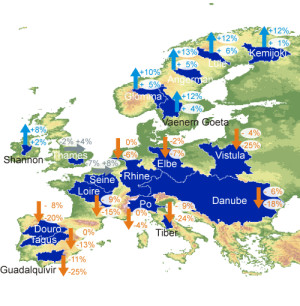Human Health | Forest Fire | Wind Storms | Water and Floods | Energy
Water is vital for life on earth. It sustains health, ecosystems and economies and a wide range of economic sectors depend on it, for example agriculture, industry, energy and tourism. The demand for water within society is rising. Using projections of future climates as input for a global hydrological model the impact on long-term water availability in European river basins has been investigated recently. Water availability here is defined as the amount of total renewable water resources accessible for use by mankind.
In northern European river basins, water availability is likely to increase overall by 5%-12%. The change in water availability in the Thames and Seine basins is ambiguous with values of change between -7% to +8% depending on the climate input. Basins in southern Europe show a tendency towards decreasing water availability by overall -5% to -20%.
While elevated water availability increases the risk of floods, lower water availability can affect water quality and lead to water stress. Projected climate changes will intensify the water stress situation especially in the Tiber, Guadalquivir and Rhine basins based on a number of water stress indicators.

The arrows in the figure show the direction of change in long-term average water availability between current conditions (1961-1990) and the 2050s (2035-2065). Results are based on calculations with the integrated global water model ‘WaterGAP’. The percentages give the span of changes that result from the use of an ensemble of climate model outputs as input to the hydrological model.
